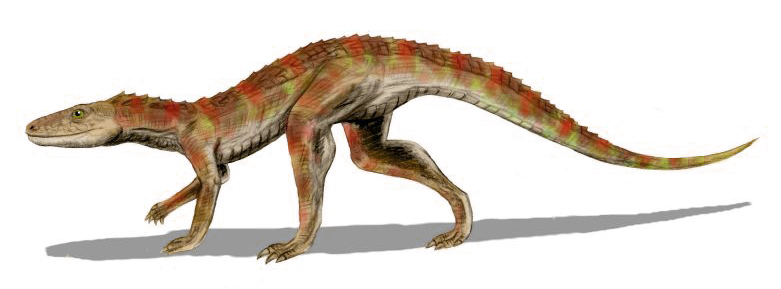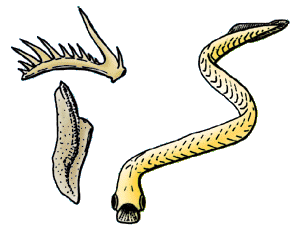|
Crocodylomorpha
Crocodylomorpha is a group of pseudosuchian archosaurs that includes the crocodilians and their extinct relatives. They were the only members of Pseudosuchia to survive the end-Triassic extinction. During Mesozoic and early Cenozoic times, crocodylomorphs were far more diverse than they are now. Triassic forms were small, lightly built, active terrestrial animals. The earliest and most primitive crocodylomorphs are represented by " sphenosuchians", a paraphyletic assemblage containing small-bodied forms with elongated limbs that walked upright, which represents the ancestral morphology of Crocodylomorpha. These forms persisted until the end of the Jurassic. During the Jurassic, Crocodylomorphs morphologically diversified into numerous niches, including into the aquatic and marine realms. Evolutionary history When their extinct species and stem group are examined, the crocodylian lineage (clade Pseudosuchia, formerly Crurotarsi) proves to have been a very diverse and adaptive ... [...More Info...] [...Related Items...] OR: [Wikipedia] [Google] [Baidu] |
Litargosuchus
''Litargosuchus'' is a sphenosuchian Crocodylomorpha, crocodylomorph, a Basal (phylogenetics), basal member of the Crocodylomorpha, crocodylomorph clade from the Early Jurassic of South Africa. Its genus name ''Litargosuchus'' is derived from Greek meaning "fast running crocodile" and its species name ''leptorhynchus'' refers to its Gracility, gracile snout. ''Litargosuchus'', along with all of South Africa's Crocodylomorpha, crocodylomorph Taxon, taxa, are confined to the upper Elliot Formation (UEF) in South Africa. History of discovery In 1988 James Kitching found the holotype fossil of ''Litargosuchus'' in a field expedition in Eagles Crag, a farm near Barkly East in the Eastern Cape. The material recovered consisted of a near-complete skull with its mandible and several bones belonging to the postcranial skeleton. At the time, James Kitching, Kitching was the director of the Evolutionary Studies Institute (previously the Bernard Price Institute) of the University of the Witw ... [...More Info...] [...Related Items...] OR: [Wikipedia] [Google] [Baidu] |
Saltoposuchus
''Saltoposuchus'' is an extinct genus of small (1-1.5 m and 10-15 kg), long-tailed crocodylomorph reptile (Sphenosuchia), from the Norian (Late Triassic) of Europe. The name translated means "leaping foot crocodile". It has been proposed that ''Terrestrisuchus gracilis'' and ''Saltoposuchus connectens'' represent different ontogenetic stages of the same genus. ''Saltoposuchus'' was commonly (and incorrectly) referred to in popular literature as the ancestor (or close ancestors) to dinosaurs, however, recent scientific research show that this is not the case. Description and Paleobiology Fossil evidence of Sphenosuchia and early crocodylomorphs lead paleontologists to conclude that ''Saltoposuchus'' is a terrestrial animal. As a monophyletic group of crocodylomorphs, Saltoposuchidae have many key morphological traits shared with most crocodylomorphs. Skull Much like other crocodylomorphs, ''Saltoposuchus'' skulls had a (reduced) antorbital fenestra, an overhanging squa ... [...More Info...] [...Related Items...] OR: [Wikipedia] [Google] [Baidu] |
Terrestrisuchus
''Terrestrisuchus'' is an extinct genus of very small early crocodylomorph that was about long. Fossils have been found in Wales and Southern England and date from near the very end of the Late Triassic during the Rhaetian, and it is known by type and only known species ''T. gracilis''. ''Terrestrisuchus'' was a long-legged, active predator that lived entirely on land, unlike modern crocodilians. It inhabited a chain of tropical, low-lying islands that made up southern Britain, along with similarly small-sized dinosaurs and abundant rhynchocephalians. Numerous fossils of ''Terrestrisuchus'' are known from fissures in limestone karst which made up the islands it lived on, which formed caverns and sinkholes that preserved the remains of ''Terrestrisuchus'' and other island-living reptiles. Description ''Terrestrisuchus'' was a small, slender crocodylomorph with very long legs, quite unlike modern crocodilians. It was initially estimated to have been between long, although this e ... [...More Info...] [...Related Items...] OR: [Wikipedia] [Google] [Baidu] |
Pseudosuchia
Pseudosuchia is one of two major divisions of Archosauria, including living crocodilians and all archosaurs more closely related to crocodilians than to birds. Pseudosuchians are also informally known as "crocodilian-line archosaurs". Prior to 2011, the clade Pseudosuchia was often called Crurotarsi in reference to the crurotarsal ankle found in almost all members of the group, which traditionally included phytosaurs, ornithosuchids, and suchians. However, a major 2011 study of Triassic archosaur relations proposed that phytosaurs were not closely related to other traditional "crurotarsans", at least compared to "bird-line archosaurs" (Avemetatarsalians) such as pterosaurs and dinosaurs. As a result, the possession of a crurotarsal ankle was considered a plesiomorphic ("primitive") feature retained by pseudosuchians. Crurotarsi now refers to a broader group of reptiles including Pseudosuchia, Phytosauria, and Avemetatarsalia. Despite Pseudosuchia meaning "false crocodiles", th ... [...More Info...] [...Related Items...] OR: [Wikipedia] [Google] [Baidu] |
Archosaur
Archosauria () is a clade of diapsids, with birds and crocodilians as the only living representatives. Archosaurs are broadly classified as reptiles, in the cladistic sense of the term which includes birds. Extinct archosaurs include non-avian dinosaurs, pterosaurs, and extinct relatives of crocodilians. Modern paleontologists define Archosauria as a crown group that includes the most recent common ancestor of living birds and crocodilians, and all of its descendants. The base of Archosauria splits into two clades: Pseudosuchia, which includes crocodilians and their extinct relatives, and Avemetatarsalia, which includes birds and their extinct relatives (such as non-avian dinosaurs and pterosaurs). Older definitions of the group Archosauria rely on shared morphological characteristics, such as an antorbital fenestra in the skull, serrated teeth, and an upright stance. Some extinct reptiles, such as proterosuchids and euparkeriids, possessed these features yet originated pri ... [...More Info...] [...Related Items...] OR: [Wikipedia] [Google] [Baidu] |
Triassic–Jurassic Extinction Event
The Triassic–Jurassic (Tr-J) extinction event, often called the end-Triassic extinction, marks the boundary between the Triassic and Jurassic periods, , and is one of the top five major extinction events of the Phanerozoic eon, profoundly affecting life on land and in the oceans. In the seas, the entire Class (biology), class of conodonts and 23–34% of marine genus, genera disappeared. On land, all Archosauromorpha, archosauromorphs other than Crocodylomorpha, crocodylomorphs, pterosaurs, and dinosaurs became extinct; some of the groups which died out were previously abundant, such as aetosaurs, phytosaurs, and Rauisuchidae, rauisuchids. Some remaining non-mammalian therapsids and many of the large Temnospondyli, temnospondyl amphibians had become extinct prior to the Jurassic as well. However, there is still much uncertainty regarding a connection between the Tr-J boundary and terrestrial vertebrates, due to a lack of terrestrial fossils from the Rhaetian (latest) stage of the ... [...More Info...] [...Related Items...] OR: [Wikipedia] [Google] [Baidu] |
Crocodyliformes
Crocodyliformes is a clade of crurotarsan archosaurs, the group often traditionally referred to as "crocodilians". They are the first members of Crocodylomorpha to possess many of the features that define later relatives. They are the only pseudosuchians to survive the K-Pg extinction event. In 1988, Michael J. Benton and James M. Clark argued that all traditional names for well-known groups of animals should be restricted to their crown clades, that is, used only for natural groups comprising all living members of any given lineage. This posed a problem for the crocodilians, because the name Crocodylia, while used in various ways by various scientists, had always included not only living crocodilians but many of their extinct ancestors known only from the fossil record.Benton, M.J. and Clark, J.M. (1988). "Archosaur phylogeny and the relationships of the Crocodylia." Pp. 295–338 in Benton, M.J. (ed.), ''The phylogeny and classification of the Tetrapods, volume 1''. Oxford: Cl ... [...More Info...] [...Related Items...] OR: [Wikipedia] [Google] [Baidu] |
Sphenosuchia
Sphenosuchia is a suborder of basal crocodylomorphs that first appeared in the Triassic and occurred into the Middle Jurassic. Most were small, gracile animals with an erect limb posture. They are now thought to be ancestral to crocodyliforms, a group which includes all living crocodilians. Stratigraphic range The earliest known members of the group (i.e. '' Hesperosuchus'') are early Norian in age, found in the Blue Mesa Member of the Chinle Formation. Only one sphenosuchian is currently known from the Middle Jurassic, ''Junggarsuchus'', from the Junggar Basin (Shishugou Formation) of China during either the Bathonian or the Callovian (~165 Ma) age,Clark, J.M., ''et al.'' (2004A Middle Jurassic 'sphenosuchian' from China and the origin of the crocodylian skull''Nature'' 430:1021-1024. and the Hallopodidae are known from the Late Jurassic of North America. Phylogeny The monophyly of the group is debated, although several synapomorphies characterize the clade, including extreme ... [...More Info...] [...Related Items...] OR: [Wikipedia] [Google] [Baidu] |
Thalattosuchia
Thalattosuchia is a clade of marine crocodylomorphs from the Early Jurassic to the Early Cretaceous that had a cosmopolitan distribution. They are colloquially referred to as marine crocodiles or sea crocodiles, though they are not members of Crocodilia and records from Thailand and China suggest that some members lived in freshwater. The clade contains two major subgroupings, the Teleosauroidea and Metriorhynchoidea. Teleosauroids are not greatly specialised for oceanic life, with back osteoderms similar to other crocodyliformes. Within Metriorhynchoidea, the Metriorhynchidae displayed extreme adaptions for life in the open ocean, including the transformation of limbs into flippers, the development of a tail fluke, and smooth, scaleless skin. Discovery and naming The term Thalattosuchia was coined by Fraas in 1901.Fraas E. 1901. Die Meerkrokodile (Thalattosuchia n. g.) eine neue Sauriergruppe der Juraformation. ''Jahreshefte des Vereins für vaterländische Naturkunde, Württem ... [...More Info...] [...Related Items...] OR: [Wikipedia] [Google] [Baidu] |
Stem Group
In phylogenetics, the crown group or crown assemblage is a collection of species composed of the living representatives of the collection, the most recent common ancestor of the collection, and all descendants of the most recent common ancestor. It is thus a way of defining a clade, a group consisting of a species and all its extant or extinct descendants. For example, Neornithes (birds) can be defined as a crown group, which includes the most recent common ancestor of all modern birds, and all of its extant or extinct descendants. The concept was developed by Willi Hennig, the formulator of phylogenetic systematics, as a way of classifying living organisms relative to their extinct relatives in his "Die Stammesgeschichte der Insekten", and the "crown" and "stem" group terminology was coined by R. P. S. Jefferies in 1979. Though formulated in the 1970s, the term was not commonly used until its reintroduction in 2000 by Graham Budd and Sören Jensen. Contents of the crown gr ... [...More Info...] [...Related Items...] OR: [Wikipedia] [Google] [Baidu] |
Hallopodidae
Hallopodidae is a family of Late Jurassic crocodylomorphs. They have been recovered as the closest relatives of the Crocodyliformes Crocodyliformes is a clade of crurotarsan archosaurs, the group often traditionally referred to as "crocodilians". They are the first members of Crocodylomorpha to possess many of the features that define later relatives. They are the only pseudo .... References Prehistoric reptile families Late Jurassic crocodylomorphs Fossil taxa described in 1881 {{Jurassic-reptile-stub ... [...More Info...] [...Related Items...] OR: [Wikipedia] [Google] [Baidu] |
Carnufex
''Carnufex'' is an extinct genus of crocodylomorph suchian from the Late Triassic of North America. The genus was first described in 2015 by Zanno ''et al.'', who named the Binomial nomenclature, binomial ''Carnufex carolinensis'', meaning "Carolina butcher". Two specimens are known, the holotype skull and skeleton NCSM 21558, and the referred humerus NCSM 21623. The specimens are from the Carnian-age Pekin Formation, which dates to 231 million years ago. Based on the holotype, ''Carnufex'' would have been about long and tall, although it may have gotten larger due to the holotype not being fully grown. Discovery NCSM 21558 was discovered in a red Fluvial processes, fluvial Conglomerate (geology), conglomerate belonging to the mid-upper portion Pekin Formation of North Carolina, which formed in the Carnian age of the Late Triassic, around 231 million years ago. This specimen was described in a 2015 ''Scientific Reports'' article by Lindsay Zanno, Lindsay E. Zanno, Susan Drymal ... [...More Info...] [...Related Items...] OR: [Wikipedia] [Google] [Baidu] |

.jpg)




